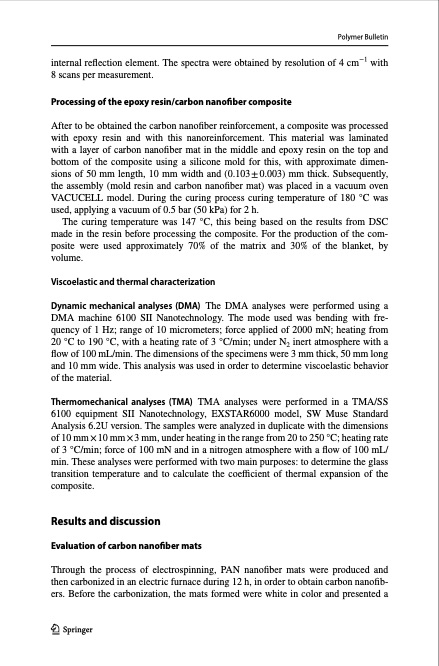
PDF Publication Title:
Text from PDF Page: 005
internal reflection element. The spectra were obtained by resolution of 4 cm−1 with 8 scans per measurement. Processing of the epoxy resin/carbon nanofiber composite After to be obtained the carbon nanofiber reinforcement, a composite was processed with epoxy resin and with this nanoreinforcement. This material was laminated with a layer of carbon nanofiber mat in the middle and epoxy resin on the top and bottom of the composite using a silicone mold for this, with approximate dimen- sions of 50 mm length, 10 mm width and (0.103±0.003) mm thick. Subsequently, the assembly (mold resin and carbon nanofiber mat) was placed in a vacuum oven VACUCELL model. During the curing process curing temperature of 180 °C was used, applying a vacuum of 0.5 bar (50 kPa) for 2 h. The curing temperature was 147 °C, this being based on the results from DSC made in the resin before processing the composite. For the production of the com- posite were used approximately 70% of the matrix and 30% of the blanket, by volume. Viscoelastic and thermal characterization Dynamic mechanical analyses (DMA) The DMA analyses were performed using a DMA machine 6100 SII Nanotechnology. The mode used was bending with fre- quency of 1 Hz; range of 10 micrometers; force applied of 2000 mN; heating from 20 °C to 190 °C, with a heating rate of 3 °C/min; under N2 inert atmosphere with a flow of 100 mL/min. The dimensions of the specimens were 3 mm thick, 50 mm long and 10 mm wide. This analysis was used in order to determine viscoelastic behavior of the material. Thermomechanical analyses (TMA) TMA analyses were performed in a TMA/SS 6100 equipment SII Nanotechnology, EXSTAR6000 model, SW Muse Standard Analysis 6.2U version. The samples were analyzed in duplicate with the dimensions of 10 mm × 10 mm × 3 mm, under heating in the range from 20 to 250 °C; heating rate of 3 °C/min; force of 100 mN and in a nitrogen atmosphere with a flow of 100 mL/ min. These analyses were performed with two main purposes: to determine the glass transition temperature and to calculate the coefficient of thermal expansion of the composite. Results and discussion Evaluation of carbon nanofiber mats Through the process of electrospinning, PAN nanofiber mats were produced and then carbonized in an electric furnace during 12 h, in order to obtain carbon nanofib- ers. Before the carbonization, the mats formed were white in color and presented a 13 Polymer BulletinPDF Image | Carbon nanofibers obtained from electrospinning process

PDF Search Title:
Carbon nanofibers obtained from electrospinning processOriginal File Name Searched:
Artigoelectrospinnigprocess2019.pdfDIY PDF Search: Google It | Yahoo | Bing
Sulfur Deposition on Carbon Nanofibers using Supercritical CO2 Sulfur Deposition on Carbon Nanofibers using Supercritical CO2. Gamma sulfur also known as mother of pearl sulfur and nacreous sulfur... More Info
CO2 Organic Rankine Cycle Experimenter Platform The supercritical CO2 phase change system is both a heat pump and organic rankine cycle which can be used for those purposes and as a supercritical extractor for advanced subcritical and supercritical extraction technology. Uses include producing nanoparticles, precious metal CO2 extraction, lithium battery recycling, and other applications... More Info
| CONTACT TEL: 608-238-6001 Email: greg@infinityturbine.com | RSS | AMP |